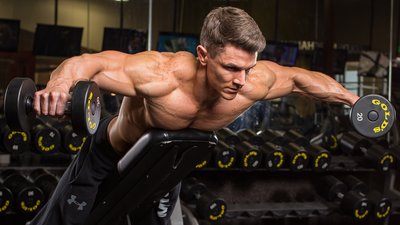Shoulder day can be as vanilla as they come; pair an overhead press with single-joint movements for all three delt heads, and voila, you've got a workout.
Never mind that this approach of 3 sets of 12 hasn't produced any appreciable gains since the second Bush administration.
So let's get you out of that rut, shall we? The approach I'm about to show you is much more effective—and fun. Advance warning: It isn't so much about the moves I chose but what you'll be doing to them that'll make this routine so brutal. And we'll start with some common lagging areas, flipping single-joint moves with the presses.
1. Rear-Delt Triset
With the typical emphasis of what you can see on the front side of the body and so much pressing, rear delts all too often take a back seat in a training program. (And don't think back training is enough to develop those rear delts.) This ill-conceived approach leaves development on the table and sets you up for aesthetic and strength imbalances, some of which could contribute to injuries.
About these movements: All three movements are performed back to back with no rest between them, except for changing exercises.
The first movement is very heavy and uses a limited range of motion. I learned rear-delt swings from IFBB pro bodybuilder John Meadows. Lie face down atop an incline bench with your head off the end of the bench; this will allow you to directly work the rear delts against gravity rather than at an angle. With the slightest bend in your elbows, let the dumbbells hang down.
"By the end of the set, you'll look more like you're twitching the dumbbells rather than lifting them," says Meadows. Do a partial reverse-fly movement. The dumbbells should be moving only about 6-8 inches. Control the weight, but let momentum aid the movement. Perform 30 repetitions. Make sure you're going heavy here!
With no rest, immediately go into a bent-over dumbbell lateral raise, a classic bodybuilding rear-delt developer, but with a twist: You'll support your forehead on the uppermost end of the incline bench. This restricts movement from the legs and lower back and greatly reduces momentum, making this a superior isolation move. Do this move with a neutral grip and full range of motion in a semicircular arc. Perform 6 reps with your max weight to failure.
Finish with the reverse pec-deck machine. If it's halfway across the gym or occupied, duplicate this movement sitting or standing with bands; band pull-aparts are a mainstay for many elite powerlifters. The machine removes any stability requirements and will allow you to fully concentrate on finishing off your rear delts.
Grab the handles with a pronated or neutral grip. Use a full range of motion for 12 reps using your 12RM weight, holding the peak-contracted position for a full count.
Doing all three movements together is brutal. But as national-level bodybuilder TJ Clark shows, it's a phenomenal way to kick-start rear-delt growth.
TRAINING TIPS
- Rear-delt swings aren't a grip test—it's okay and even encouraged to wear wrist straps. The rear delts respond well to lots of reps and heavy weight, and this movement introduces both.
- Don't be afraid to use a little momentum, unlike most other bodybuilding movements. If you know your single-rep max for this movement using a full range of motion, double that weight.
- Keep your arms locked in the slightly bent position throughout the entire movement when performing the reverse pec deck. The motion should be restricted to the shoulder joint.
- Perform three trisets; go as heavy as possible on each one, so long as you reach the target reps, resting 2-3 minutes between trisets. You'll more than likely need to reduce the weight by 10-15 percent on each movement of each successive triset; otherwise, accumulated fatigued will quickly lower your rep totals.
2. Partial Cable Lateral Raise
Lateral raises are the go-to movement for beefing up those middle delt "caps." Though many overhead presses are great for overloading the middle delts, isolation exercises are needed for next-level growth. Since the bottom-most portion of lateral raises largely targets the supraspinatus, the focus here instead is on the top portion. Using partial reps, that area of the ROM will now be overloaded to a greater degree, which should spark growth.
About the movement: Stand sideways to the cable (attach a D-handle to the low pulley) but for this move, you're going to use the arm closest to the weight stack, which changes the angle of pull from the way you normally do a lateral raise. Bring the handle to a height that starts the lateral raise at approximately one-third of the way up of a full repetition. From this position, with the elbow locked in a slightly bent position, raise your arm using the middle delt out to your side (lateral plane) until your elbow is about shoulder height.
It's a slightly different motion than what you may be used to when doing lateral raises with your outside hand; instead, the angle of pull is nearly vertical, which Clark clearly demonstrates.
TRAINING TIPS
- This is an isolation movement, so there's no room for cheating here. Focus on the muscle doing the work, not on moving the weight.
- Perform 3 sets of 12 reps, using the heaviest weight possible that allows for no form deviation. Lift the weight up under control, using a 2- to 3-second negative. Using a reduced range of motion to maintain control is better than performing a full ROM will allow you to further isolate what is already an isolation move.
3. Half, Half, Full Dumbbell Press
The most muscular bodybuilders of all time have included a variation of overhead presses in their programs, and so have the strongest men in the world. Even John Grimek, who many consider to be the father of modern bodybuilding, at one time held the world record in the overhead press.
I've saved the presses for last in favor of hitting some typically neglected areas, but now it's time to finish heavy and hard with an overhead pressing variation that maximizes muscular tension.
About the movement: Sit on a low-back bench. Rest the dumbbells on your shoulders to initiate the movement, push the weight halfway up, return to the start position, push the weight halfway up again, return to the start position, then push the weights all the way up. This three-movement sequence constitutes one rep.
Why just one segment of the three to full arm extension? That's to ensure more emphasis remains on the middle and front delts while still allowing you to complete occasional full-range reps, as Clark demonstrates performing the full movement. Your triceps work harder as you fully extend your arms, so this pattern reduces the degree of stress they receive.
TRAINING TIPS
- Control the negative, and explode on the positive. This stresses the deltoids and increases time under tension.
- Perform this movement for 3 sets of 6 reps, going as heavy as possible and taking a full recovery between each set. At this point of the workout, use a weight with which you can complete 12 reps under normal circumstances.
- This movement can also be performed with a barbell.

